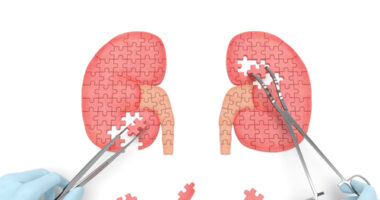Protein Imbalance Theory Unifies Kidney Diseases, Researcher Argues, But Doesn’t Explain Alport Mutations

An imbalance in protein-related processes in the body is behind a variety of kidney diseases, including Alport syndrome, a top Korean researcher argues. But his arguments don’t shed new light about the mechanisms leading to Alport, or insights that might lead to new treatments for the progressive disease.
The hypothesis, which the Catholic University of Korea‘s Kyung-Yil Lee has dubbed the protein-homeostasis-system hypothesis and which he’s applied to other research fields, can explain conditions as disparate as cancer, infectious diseases and immune-related conditions, he claims.
Lee’s article, “A unified pathogenesis for kidney diseases, including genetic diseases and cancers, by the protein-homeostasis-system hypothesis,” appears in the journal Kidney Research and Clinical Practice and focuses solely on kidney conditions.
Homeostasis means balance, and a lack of balance can, in certain cases, contribute to disease. This theory, he claims, can explain why people in a family affected by a specific Alport mutation can show symptoms in a wide range of severity. In addition, he said, different gene mutations among Alport patients can give rise to similar symptoms and disease courses.
These differences can be explained with the help of the protein-homeostasis-system hypothesis — for which Lee and his colleagues are currently the only proponents. The theory states that the health of an organism may be controlled by a protein network. The immune system is part of this network and therefore affects various kidney diseases.
The mutations causing Alport syndrome, affecting the COL4A3, COL4A4, and COL4A5 genes, affect a collagen chain that is needed in the basement membrane of the kidney — the structure required for the proper filtration of urine.
But in many patients with known mutations, examinations with high-resolution microscopy shows no changes to the basement membrane during a child’s first decade of life. This would indicate that mechanisms act to produce compensatory or alternative proteins in cases a protein is defective, as is the case in Alport.
These mechanisms are part of the protein-homeostasis system, Lee argued. “Thus, patients who can induce proper alternative proteins might have a less severe clinical course and a better prognosis,” he wrote. “The PHS hypothesis is very simple, but it could unify the pathogenesis of kidney diseases, including genetic diseases and cancers, as well as the mode of mechanisms in development, growth, and activity of an organism.”
However, Lee doesn’t explain how a simple theory of the imbalance of unspecified proteins can bring any insights into the mechanisms of — and hence advance treatments — of a condition such as Alport syndrome.







Leave a comment
Fill in the required fields to post. Your email address will not be published.